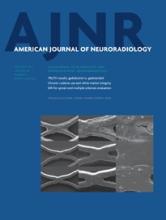Index by author
Mitra, D.
- InterventionalYou have accessTreatment of Poor-Grade Subarachnoid Hemorrhage TrialD. Mitra, B. Gregson, V. Jayakrishnan, A. Gholkar, A. Vincent, P. White and P. MitchellAmerican Journal of Neuroradiology January 2015, 36 (1) 116-120; DOI: https://doi.org/10.3174/ajnr.A4061
Modica, C.M.
- BrainYou have accessIron and Volume in the Deep Gray Matter: Association with Cognitive Impairment in Multiple SclerosisC.M. Modica, R. Zivadinov, M.G. Dwyer, N. Bergsland, A.R. Weeks and R.H.B. BenedictAmerican Journal of Neuroradiology January 2015, 36 (1) 57-62; DOI: https://doi.org/10.3174/ajnr.A3998
Morais, L.T.
- FELLOWS' JOURNAL CLUBBrainOpen AccessPercentage Insula Ribbon Infarction of >50% Identifies Patients Likely to Have Poor Clinical Outcome Despite Small DWI Infarct VolumeV.M. Timpone, M.H. Lev, S. Kamalian, L.T. Morais, A.M. Franceschi, L. Souza and P.W. SchaeferAmerican Journal of Neuroradiology January 2015, 36 (1) 40-45; DOI: https://doi.org/10.3174/ajnr.A4091
Using CT or DWI, the authors categorized percentages of insular ribbon infarctions as less or more than 50% and correlated these with clinical outcomes. Only insular ribbon involvement greater than 50% and low NIHSS score at admission correlated with poor outcomes. They concluded that DWI–percentage insula ribbon infarct of >50% independently predicted poor clinical outcome and can help identify patients with stroke likely to have poor outcome despite small admission DWI lesion volumes.
Morales-valero, S.F.
- FELLOWS' JOURNAL CLUBInterventionalYou have accessRescue Treatment of Thromboembolic Complications during Endovascular Treatment of Cerebral Aneurysms: A Meta-AnalysisW. Brinjikji, S.F. Morales-Valero, M.H. Murad, H.J. Cloft and D.F. KallmesAmerican Journal of Neuroradiology January 2015, 36 (1) 121-125; DOI: https://doi.org/10.3174/ajnr.A4066
The authors evaluated the results reported in 23 studies that included 516 patients in whom different drugs were used for rescue therapy in thromboembolic complications during endovascular treatment of intracranial aneurysms. The literature shows that rescue therapy with thrombolytic agents resulted in significantly more morbidity than rescue therapy with glycoprotein IIb/IIIa inhibitors. Tirofiban/eptifibatide resulted in significantly higher recanalization rates compared with abciximab.
Mori, S.
- BrainOpen AccessMacro- and Microstructural Changes in Patients with Spinocerebellar Ataxia Type 6: Assessment of Phylogenetic Subdivisions of the Cerebellum and the Brain StemK. Sato, K. Ishigame, S.H. Ying, K. Oishi, M.I. Miller and S. MoriAmerican Journal of Neuroradiology January 2015, 36 (1) 84-90; DOI: https://doi.org/10.3174/ajnr.A4085
Mourand, I.
- BrainYou have accessPatient Selection for Stroke Endovascular Therapy— DWI-ASPECTS Thresholds Should Vary among Age Groups: Insights from the RECOST StudyF. Danière, K. Lobotesis, P. Machi, O. Eker, I. Mourand, C. Riquelme, X. Ayrignac, J.F. Vendrell, G. Gascou, J. Fendeleur, C. Dargazanli, R. Schaub, H. Brunel, C. Arquizan, A. Bonafé and V. CostalatAmerican Journal of Neuroradiology January 2015, 36 (1) 32-39; DOI: https://doi.org/10.3174/ajnr.A4104
Muhlau, M.
- FELLOWS' JOURNAL CLUBSpineYou have accessDouble Inversion Recovery Sequence of the Cervical Spinal Cord in Multiple Sclerosis and Related Inflammatory DiseasesI. Riederer, D.C. Karampinos, M. Settles, C. Preibisch, J.S. Bauer, J.F. Kleine, M. Mühlau and C. ZimmerAmerican Journal of Neuroradiology January 2015, 36 (1) 219-225; DOI: https://doi.org/10.3174/ajnr.A4093
Double inversion recovery was used to study 30 patients with suspected or established MS and images were blindly evaluated by 2 neuroradiologists. DIR detected 28% more lesions than T2-weighted images with higher contrast-to-noise ratios leading to increased rating in lesion visibility. The authors concluded that the DIR sequence allowed better detection of lesions in MS and related inflammatory diseases of the cervical spinal cord compared with conventional T2WI.
Murad, M.H.
- FELLOWS' JOURNAL CLUBInterventionalYou have accessRescue Treatment of Thromboembolic Complications during Endovascular Treatment of Cerebral Aneurysms: A Meta-AnalysisW. Brinjikji, S.F. Morales-Valero, M.H. Murad, H.J. Cloft and D.F. KallmesAmerican Journal of Neuroradiology January 2015, 36 (1) 121-125; DOI: https://doi.org/10.3174/ajnr.A4066
The authors evaluated the results reported in 23 studies that included 516 patients in whom different drugs were used for rescue therapy in thromboembolic complications during endovascular treatment of intracranial aneurysms. The literature shows that rescue therapy with thrombolytic agents resulted in significantly more morbidity than rescue therapy with glycoprotein IIb/IIIa inhibitors. Tirofiban/eptifibatide resulted in significantly higher recanalization rates compared with abciximab.








